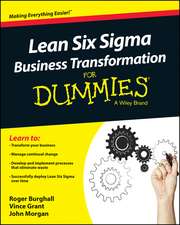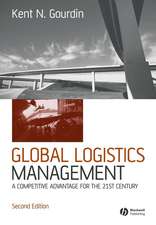Innovation in Production: The Adoption and Impacts of New Manufacturing Concepts in German Industry: Technology, Innovation and Policy (ISI), cartea 8
Editat de Gunter Lay, Philip Shapira, Jürgen Wengelen Limba Engleză Paperback – 26 noi 1998
Preț: 383.12 lei
Nou
Puncte Express: 575
Preț estimativ în valută:
73.31€ • 76.54$ • 60.67£
73.31€ • 76.54$ • 60.67£
Carte tipărită la comandă
Livrare economică 04-18 aprilie
Preluare comenzi: 021 569.72.76
Specificații
ISBN-13: 9783790811407
ISBN-10: 3790811408
Pagini: 208
Ilustrații: XVI, 188 p.
Dimensiuni: 155 x 235 x 11 mm
Greutate: 0.3 kg
Ediția:Softcover reprint of the original 1st ed. 1999
Editura: Physica-Verlag HD
Colecția Physica
Seria Technology, Innovation and Policy (ISI)
Locul publicării:Heidelberg, Germany
ISBN-10: 3790811408
Pagini: 208
Ilustrații: XVI, 188 p.
Dimensiuni: 155 x 235 x 11 mm
Greutate: 0.3 kg
Ediția:Softcover reprint of the original 1st ed. 1999
Editura: Physica-Verlag HD
Colecția Physica
Seria Technology, Innovation and Policy (ISI)
Locul publicării:Heidelberg, Germany
Public țintă
ResearchCuprins
1 Introduction: Perspectives on German Industry and its Competitiveness.- 1.1 German Industrial Competitiveness in Context.- 1.2 The German Investment Goods Sector.- 1.3 Overview of Innovation in Production.- 1.4 Bibliography.- 2 The Diffusion of New Production Concepts in Germany.- 2.1 Introduction.- 2.2 Principles of New Production Concepts.- 2.3 Implementation of New Production Concepts.- 2.4 Diffusion and Structural Characteristics of Manufacturers.- 2.5 The Dynamics of Diffusion.- 2.6 Conclusions.- 2.7 Bibliography.- 3 Performance Impacts of new Production Concepts.- 3.1 Introduction.- 3.2 New Production Concepts and Productivity.- 3.3 New Production Concepts and Quality.- 3.4 New Production Concepts and Inventory Savings.- 3.5 Comparative Impacts of New Production Concepts by Industry and Employment Size.- 3.6 Importance of Specific Elements of New Production Concepts for Individual Manufacturers.- 3.7 Conclusions.- 3.8 Bibliography.- 4 Interaction of Process and Product Innovation.- 4.1 Introduction.- 4.2 New Production Concepts and Product Innovation.- 4.3 Influence of New Production Concepts on Product Development Timing.- 4.4 Conclusions.- 4.5 Bibliography.- 5 New Production Concepts and Employment.- 5.1 Introduction.- 5.2 Development of Employment in Manufacturers: Users and Nonusers of New Production Concepts.- 5.3 Employment, New Production Concepts, and the Effects of Alternative Business Strategies.- 5.4 Differences between Cost-Oriented and Performance-Oriented Business Strategies in Shaping Production Concepts.- 5.5 Importance of Cost-Oriented and Performance-Oriented Strategies in the Realization of New Production Concepts.- 5.6 Conclusions.- 5.7 Bibliography.- 6 Worker Participation and Process Innovations.- 6.1 Introduction.- 6.2 Participatory Organizational Culture and Business Performance.- 6.3 Employee Participation and Success in Techno-Organizational Innovation Projects.- 6.4 Conclusions.- 6.5 Bibliography.- 7 Flexibility at Work.- 7.1 Introduction.- 7.2 Diffusion of Flexible Work Time Concepts.- 7.3 Use of Flextime by Establishment Size, Industry and Strategic Orientation.- 7.4 Influence of Product and Type of Manufacturing on the Implementation of Flextime Models.- 7.5 Influence of Work Organization on the Use of Flextime Models.- 7.6 Conclusions.- 7.7 Bibliography.- 8 Innovation Versus Emigration — new Production Concepts and Transborder Relocation.- 8.1 Introduction.- 8.2 Extent of Actual and Planned Relocations.- 8.3 Production Relocation and Strategic Orientation.- 8.4 Production Relocation and Performance Parameters.- 8.5 Production Relocations and Productivity.- 8.6 Conclusions.- 8.7 Bibliography.- 9 New Production Concepts and Service Orientation: the Case of Teleservice.- 9.1 Introduction.- 9.2 The Diffusion of Teleservice.- 9.3 Teleservice Use by Industry and Establishment Size.- 9.4 Teleservice: An Alternative to an Internal Service Department?.- 9.5 The Future Development of Teleservice in German Industry.- 9.6 Conclusions.- 9.7 Bibliography.- 10 Environmental Practices in Germany’s Investment.- 10.1 Environmentally Clean Production in German Industry?.- 10.2 Dissemination of Dry Processing Technologies.- 10.3 Dissemination of Environmental Audits.- 10.4 Conditions of Application and Effects.- 10.5 Conclusions.- 10.6 Bibliography.- 11 Adoption of New Production Concepts in East Germany.- 11.1 Introduction.- 11.2 The Modernization of Production in the New Länder.- 11.3 Manufacturing Productivity in East Germany.- 11.4 Conclusions.- 11.6 Bibliography.- 12 Promotion of Cim in the New Länder.-12.1 Introduction.- 12.2 The CIM Program and Its Context in the New Länder.- 12.3 The Coverage of the CIM Promotion Scheme.- 12.4 Project Management in CIM-Promoted and Non-Promoted Establishments.- 12.5 The Impact of the Promotion on the Firms.- 12.7 Conclusions.- 12.8 Bibliography.- 13 Implications for Modernization Strategies and Studies.- 13.1 Introduction.- 13.2 German Competitiveness, Industrial Strategy and Business Performance: Recasting the Debate.- 13.3 Implications for Management, Policy and Research.- 13.4 Bibliography.- Appendix: Study Methodology Steffen Kinkel and Martin Dreher.- A.l Introduction.- A.2 Survey Objectives and Target Industries.- A.3 Address Sources and Sample Design.- A.4 Response Rate and Structure of the Data Base.- A.5 Characteristics of Survey Respondents and Comparison with Parent Industry Population.- A.6 Weighting Scheme and Transferability of the Survey Results to the Parent Population.- A.7 Bibliography.- Contributors.- The Innovations in Production Group at the Fraunhofer Institute for Systems and Innovation Research.
Textul de pe ultima copertă
This book examines how industrial companies in Germany's critically important investment goods sector are deploying new technological and organizational production concepts to adapt to competitiveness challenges, new market requirements, environmental demands, and policy pressures. It draws on the Fraunhofer ISI's unique nationwide survey of technology use and production in Germany. East German as well as West German data is analyzed. Readers will gain fresh insights about the diffusion of new production concepts, the interaction of process and product innovations, and subsequent effects on productivity, employment, work flexibility, and the business performance of German industry. Implications for business strategy, public policy, and ongoing research into technology diffusion are considered.






















